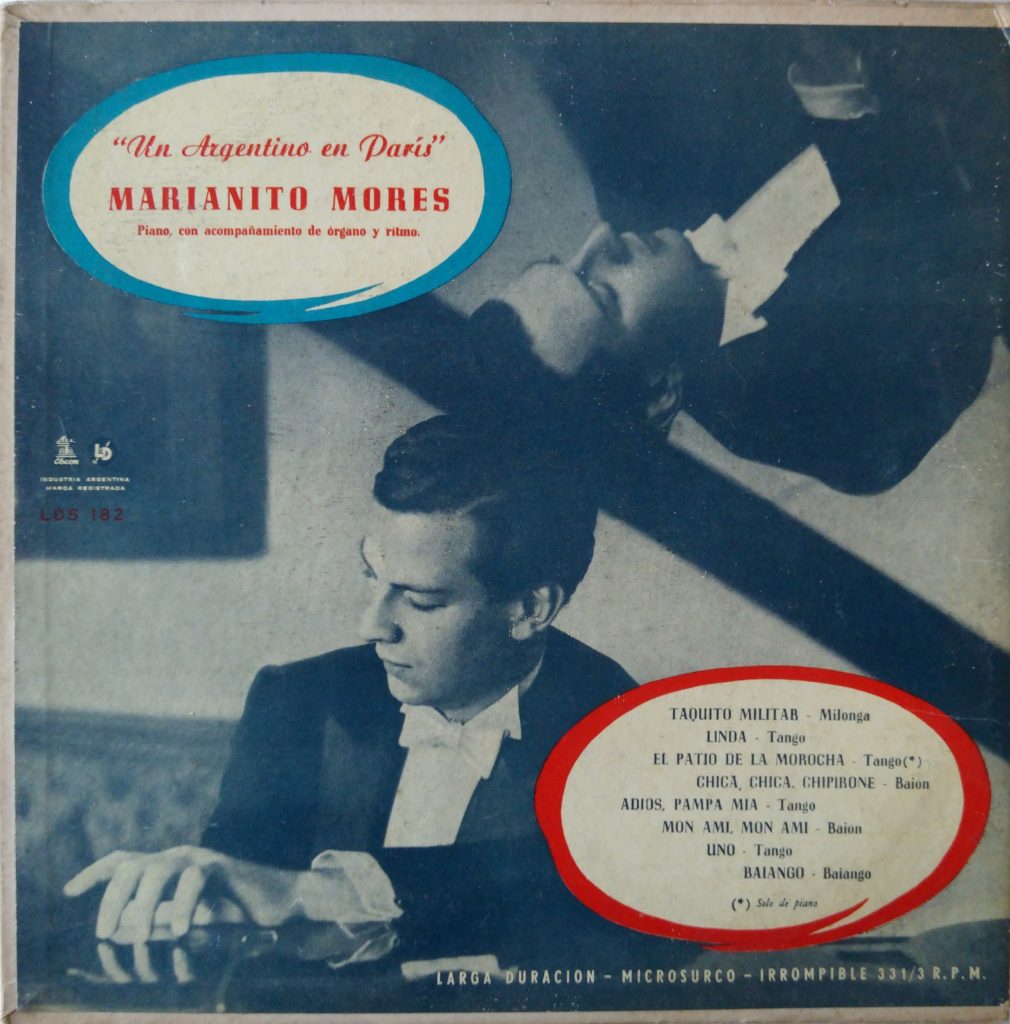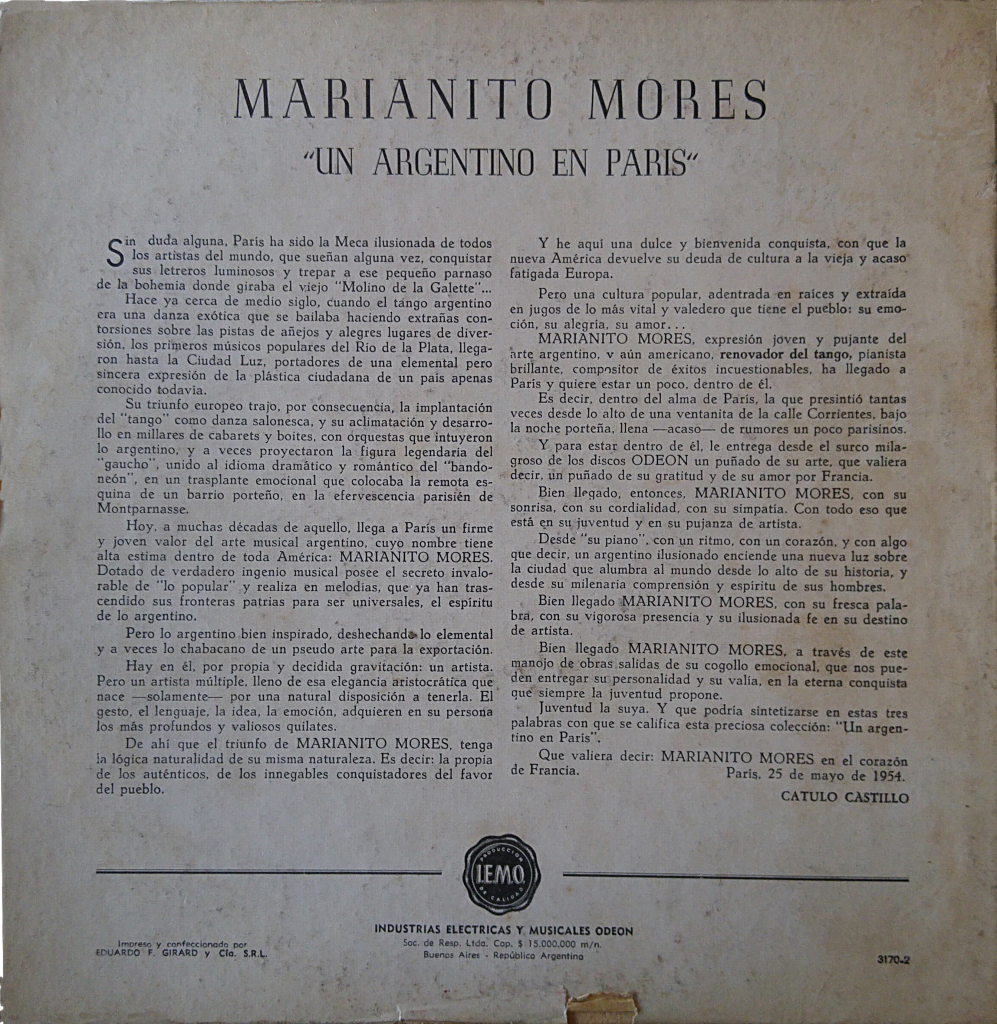As you might recall, just a couple of weeks ago on the 13.4.2016 the maestro Mariano Mores passed away. He composed some very famous tangos like Uno, Cuartito azul, Cafetín de Buenos Aires, Adiós Pampa mía, Taquito militar and many others.
Today I received a very interesting 10” LP published on the Odeón label in Buenos Aires in 1954. The titel is “Marianito Mores – Un Argentino en París – Piano con acompañamiento de órgano y ritmo“ It is less suited for dancing and has a more recital, jazzy character. The 2 x 4 titles were recorded in France (grabado en Francia) and the vinyl record then pressed and published in Buenos Aires. All tracks are composed or co-created by Mariano Mores. The record number is LDS-182, it is a very low number, so we are most likely very close to the beginning of this Odeón series which might have started as early as 1953 with some Francisco Canaro, Rodolfo Biagi and Roberto Firpo re-editions. You can crosscheck this via Christoph Lanner’s Francisco Canaro Discography, he mentions the LDS vinyl re-edtions in the Electric Recordings Part II (1935-1973). The LDS series produced also Argentine folklore and jazz titles with artists like Atahualpa Yupanqui or Oscar Alemán.
I found an extract of a copyright register with a very detailed description of some of the earliest records in this series alongside with the number of copies printed and the historical price:
Interp.: Oscar Alemán y otros. Disco Odeón No LDS 109. 1.000 ejempl. $ 49,75; Bs. As., 2 de mayo do 1953. (Argentina).
Intérp.: Trío Sánches Monjes, Ayala y otros. Disco Odeón No LDS 110. 600 ejempl. $ 49.75. Bs. As., 2 de mayo de 1953. (Argentina)
Intérp.: Oscar Alemán. Disco Odeón No LDS 111. 1.000 ejempl. $ 49.75; Bs. As., 2 de mayo de 1953. (Argentina).
Interp.: Carlos Gardel con guitarras. Disco Odeón No LDS 112. 1.600 ejempl. $ 49,75; Bs. As., 2 de mayo do 1953. (Argentina).
Source: Boletin Oficial Republica Argentina 2da sección 1953-09-01 (Obras Depositadas Bs. As., enero a mayo de 1953)
Compared to 78-rpm records of the day these early vinyl circulations were very low. The same source shows that for instance D’Arienzo’s 78-rpm record “Don Juan, Sin Balurdo, RCA 68-0236″ from 1950 was republished at 20000 copies in 1953, that’s ~20 times more circulation (plus the first issue)!
7 DE JULIO DE 1953 [...] Faz "A~T Don Juan. Tango. Letra: E. Podestá. Música: SI. s Ponzlo. Faz "B": Sin Balurdo. Tango. Letra: -Carlos Bahr. Música: J- D'Arienzo y F. Salamanca. Intérp. f Juan D'Arienzo y su orq. típica, Disco Víctor NO 68-0236. Bs. Aa." 2312163. 20.000 ejempt.- $ 9,96.
I wonder if the declaration of the number of copies was a legal requirement. If that’s the case, it must be possible to get precise circulation figures for a lot of tango recordings.
LDS-182 is the oldest South-American tango 10″ LP vinyl record I have seen so far with a genuine content directly being produced and published on this medium. During the whole 1950s most of the Argentine records were still published on 78-rpm shellac records and sometimes, at a later moment, regrouping vinyl samplers were published. According to what I have been able to verify, the Odeón LDS series was in the beginning mainly meant for such republishing editions until this Mariano Mores creation.
It is said that during the first years his stage name had been Marianito Mores, like written on the present record. Later in 1955, when the Perón gouvernment was brought down by a military putsch, being a peronist, he felt changing his name would bring him a certain protection. He called himself ever after Mariano Mores.
The oldest genuine Argentine tango vinyl production is most probably the Music-Hall 7″ series of Carlos Di Sarli starting with the record number LP-1001 and published in February 1952. On some of these small vinyls, EPs, the production site is indicated with Peru. So most likely they were produced in a plant outside of Argentina. This is certainly something to investigate more in depth … Also the fact that the series shortly after was continued to be published on shellac (which is some kind of a regression).
The following video is taken from the 1953 movie “La voz de mi ciudad” and not directly related to the record. But it contains a nice jam session around the milonga “Taquito militar“.
Please find here the back cover and I invite you to read the interesting liner notes of Cátulo Castillo written on the 25.5.1954, in a few days precisely 62 years ago:



Jens-Ingo, when was the first vinyl on RCA-Victor? 1954?
The first RCA tango vinyls were probably issued in Feb. 1957 with the 7″ AGE-1 Feliciano Brunelli, two tracks per side. Followed by Juan D’Arienzo on AGE-5 (La Cumparsita, La Puñalada, Don Juan, El Pollo Ricardo) same month and year. Then, in March 1957, D’Arienzo AVE-28 (Sentimiento de Calavera, Tucumán, Fatal y Tanguera, La Payanca). The AVE-series was not all tango, AVE-20 is for instance a David Rose and AVE-12 an Eddie Fisher record. Already in March 1957 the AGE-series reached the hundred: AGE-114 is Armando Pontier. It seems that they were massively releasing 7″ vinyls onto the market in these first months of 1957 with the AVE and AGE-series. AVE-22 through AVE-24 were Carlos Di Sarli records: for instance AVE-22 (A La Gran Muñeca, Un Desolado Corazón, Cuidado Con Los 50, Tus Palabras Y La Noche). March 1957 marks also the date of their first 10″ issues with for instance AVL-2 which is a non-tango record, AVL-6 a Carlos Di Sarli and AVL-7 which is a Juan D’Arienzo named “Tangos De Todos Los Tiempos” with 2 x 4 tracks. The AVL-series is very much like the Odeón LDS-series a mixed genre collection with tango and other popular music. So, according to my current findings, the first Argentine vinyls were issued by Music-Hall in 1952 as genuine first day issues of Carlos Di Sarli in 7″ format, followed by the Odeón 7″ DSOA-series and their 10″ LDS-series. It’s only much later in the second half of the 1950s that RCA Victor started to produce vinyls (since Feb. 1957).
Jens-Ingo, un gusto escribirte. Admiro y valoro mucho el trabajo que realizás. Quería consultarte sobre unas ediciones del sello TK que observo muy espaciadas en el tiempo. Especialmente la serie “E” donde cambia su característica etiqueta color verde/blanco por una llamativa fucsia/blanco (magenta/blanco) donde se observan matrices de diferentes años incluso ediciones de grabaciones extranjeras. Sabrías decir cuando se originó dicha serie y el motivo que las diferencia de las series “S” verde/blanco? Está la serie plata/blanco de Troilo-Grela y una serie amarilla con ediciones extranjeras.
Agradezco mucho puedas responderme. Un saludo cordial.